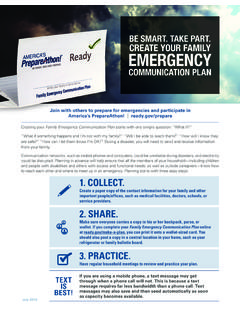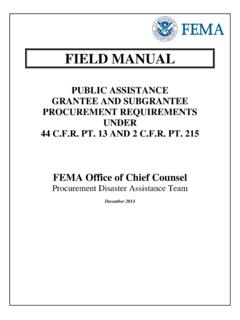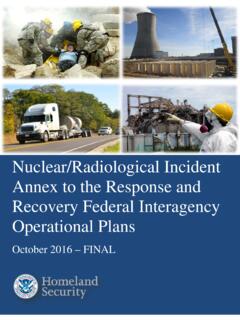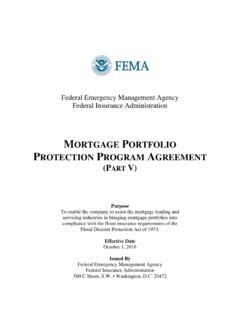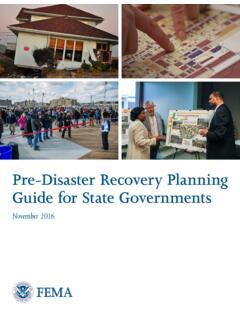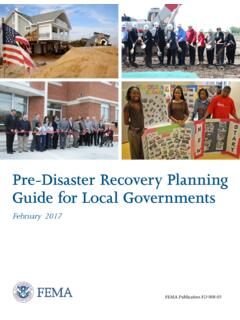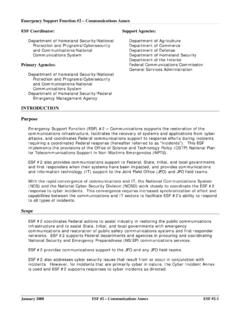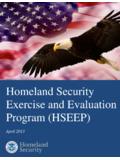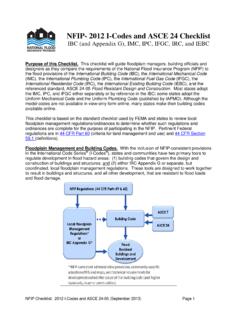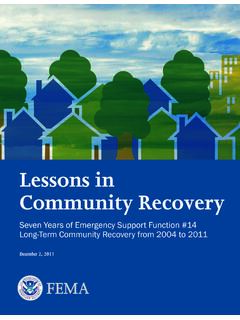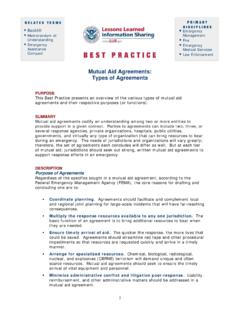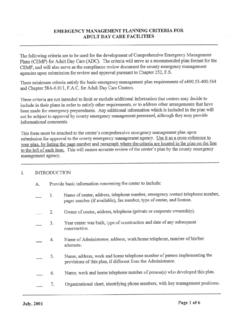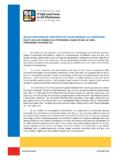Transcription of National Incident Management System - Guideline for …
1 National Incident Management System Guideline for mutual Aid November 2017 FEMA NIMS Guideline for mutual Aid NIMS Guideline for mutual Aid i Contents I. Introduction .. 1 II. Types of mutual Aid Agreements .. 2 Local Automatic mutual Aid .. 2 Local mutual Aid .. 2 Regional, Intrastate, or Statewide mutual Aid .. 3 Interstate mutual Aid After Declaration .. 3 Interstate mutual Aid Prior to or Without a Declaration .. 4 International mutual Aid .. 4 III. Key Elements of mutual Aid Agreements .. 6 Purpose and Scope .. 6 Benefits .. 6 Authorities .. 6 Definitions .. 6 Governance Structure and Operations Oversight .. 6 Recognition of Licensure and Certifications .. 7 Protocols for Interoperable Communications .. 7 Tort Liability and Indemnification .. 7 Workers Compensation .. 7 Deployment Notification .. 8 Reciprocity/Reimbursement .. 8 Termination .. 9 Dispute Resolution .. 9 Modification and Amendment Management .. 9 Operational Plan and Procedures Requirements.
2 9 Supplemental Information Based on Declaration Status .. 9IV. Key Elements of mutual Aid Operational Plans .. 11 Implementation, Schedule, Training, and Exercises .. 11 Identifying mutual Aid Resources .. 11 NIMS Guideline for mutual Aid ii Inventorying Resources .. 12 Mobilizing Resources (Request, Dispatch, and Response) .. 13 Performance Criteria and Metrics .. 14 Management and Coordination .. 14 Engagement Rules .. 14 Credentialing .. 15 Health and Safety .. 15 Voice and Data Interoperability .. 15 Documentation and Reporting .. 16 Demobilizing Resources .. 16 Glossary .. 17 List of Abbreviations .. 20 Resources .. 21 Emergency Management Assistance Compact (EMAC) .. 21 National Incident Management System (NIMS) .. 21 NIMS Guideline for the National Qualification System .. 21 NIMS Webpage .. 21 NIMS Guideline for mutual Aid 1 I. Introduction mutual aid agreements establish the terms under which one party provides resources personnel, teams, facilities, equipment, and supplies to another party.
3 Because most jurisdictions do not maintain sufficient resource levels to handle extreme events independently, mutual aid agreements provide a means for jurisdictions to augment their resources when needed for high-demand incidents. mutual aid agreements can support all mission areas; can be established before, during, or after incidents; and can be between all levels of government, non-governmental organizations (NGOs), and the private sector. mutual aid does not include direct Federal assistance1 or Federal response assistance provided under other department-/agency-specific authorities ( , the National Oil and Hazardous Substances Pollution Contingency Plan). The National Incident Management System Guideline for mutual Aid ( Guideline ) supplements the Resource Management component of the National Incident Management System (NIMS) by providing guidance on different types of mutual aid agreements, the key elements of a mutual aid agreement , and the key elements of mutual aid operational plans used for implementation.
4 This Guideline does not provide legal authority or direction and does not supersede applicable legal authorities and constraints at any jurisdictional level. Jurisdictional chief executives, department or agency heads, governors, tribal leaders, or private sector executives should consult with applicable legal authorities before entering into a mutual aid agreement or compact. By identifying potential shortfalls and capability gaps through planning and exercises, jurisdictions can work with partners to establish mutual aid agreements as part of their preparedness actions. The mutual aid network an integrated nationwide network of mutual aid systems enhances the Nation s overall preparedness and readiness by allowing jurisdictions and organizations to account for, order, and mobilize outside resources efficiently and effectively. 1 Direct Federal Assistance (44 Code of Federal Regulations [CFR] ) refers to when a state or local government requests that a Federal agency accomplish emergency work and/or debris removal because it lacks the capability.
5 Such assistance is subject to the cost-sharing provisions and eligibility criteria. State or local governments submit requests for assistance to the appropriate FEMA Regional Administrator. If the request is approved, a mission assignment will be issued to the appropriate Federal agency. NIMS Guideline for mutual Aid 2 II. Types of mutual Aid Agreements mutual aid agreements establish the terms under which assistance is provided between two or more jurisdictions within a state and between states, and can be with and between private sector entities, NGOs, and other whole community partners. These agreements facilitate access to potentially needed resources, both prior to and following incidents or planned events. When reviewing, revising, and developing new mutual aid agreements, emergency managers should consider resources and capabilities across the whole community and ensure compliance with pertinent laws and ordinances. There are several types of mutual aid agreements and jurisdictions may need to establish different types of agreements with different partners to ensure they are able to access sufficient resources meet anticipated needs.
6 Local Automatic mutual Aid Local automatic mutual aid agreements permit the automatic dispatch and response of requested resources without Incident -specific approvals or consideration of entity boundaries. These agreements are usually basic contracts between or among neighboring local entities2 and are used under conditions when time is of the essence to save lives, prevent human suffering, or mitigate property damage following an Incident . Examples: Local first responders may routinely provide emergency services to a nearby Federal facility that does not have organic capabilities. Or, this agreement may also include a Federal entity providing automatic response. A fire department from a military installation may respond to an automobile accident outside of its gate because it is the closest appropriate emergency resource, even though the area where the accident occurred is outside the fire department s area of responsibility. Local mutual Aid Local mutual aid agreements between neighboring jurisdictions or organizations involve a formal request for assistance and generally cover a larger geographic area than local automatic mutual aid agreements do.
7 Under these agreements, local resources may be used to assist Federal departments and agencies in fulfilling their missions under special circumstances, and vice versa. Incorporating private sector, NGO, and community-/faith-based organizations into the mutual aid network provides parties with access to significant additional resources. Example: Utility companies, whether privately or publicly owned, typically enter into mutual aid agreements with local communities. While utilities can refer to a wide range of services provided to the public, common utility mutual aid agreements provide for electrical, water, wastewater, and other services, such as cybersecurity assistance. Emergency aid and 2 Local entities may include nearby governments (including Federal Government installations), private sector facilities, NGOs, and faith-based organizations. NIMS Guideline for mutual Aid 3 assistance may be provided in the form of personnel, equipment, materials, and other associated services, as necessary.
8 Regional, Intrastate, or Statewide3 mutual Aid Sub-state regional mutual aid agreements are between multiple jurisdictions that are often sponsored by a council of governments or a similar regional body. Statewide/intrastate mutual aid agreements are often coordinated through the state and incorporate both state and local governmental and nongovernmental assets in an attempt to increase preparedness statewide. This approach can help reduce the number of local and jurisdiction-to-jurisdiction mutual aid agreements. In some instances, state law requires participation in an intrastate mutual aid System . Examples: The International Association of Fire Chiefs (IAFC) developed a National Fire Service Intrastate mutual Aid System (IMAS) that ties local fire districts and departments into statewide mutual aid networks. IAFC uses the mutual Aid Net tool to manage and dispatch all -hazard resources, individually or through mission-ready packages (MRP), in support of IMAS. The mutual Aid Box Alarm System (MABAS) is a structured, planned mutual aid System for deploying fire, rescue, and emergency medical services personnel in a multijurisdictional and/or multi-agency response within a state.
9 Illinois, Wisconsin, Indiana, Michigan, and parts of Missouri and Iowa use MABAS. MABAS connects fire, emergency Management services (EMS), and special operations teams in hazardous materials, technical rescue, subsurface ice/water rescue, fire investigations, Incident Management , urban search and rescue, and station backfill coverage with standby firefighting and EMS resources through mutual aid requests. Interstate mutual Aid After Declaration Out-of-state assistance through formal state-to-state agreements that support the response effort. Interstate mutual aid can be established through various types of vehicles, such as interstate compacts and agreements, Federal agreements, and sub-geographic plans. Many states have legislation to support these agreements. An example of an interstate mutual aid compact is the Emergency Management Assistance Compact (EMAC), which is administered by the National Emergency Management Association. 3 For the purposes of this document, state refers to the 56 states, territories, and insular areas (which includes any state of the United States, the District of Columbia, the Commonwealth of Puerto Rico, the Virgin Islands, Guam, American Samoa, and the Commonwealth of the Northern Mariana Islands).
10 Emergency Management Assistance Compact (EMAC) EMAC is a congressionally ratified agreement that provides form and structure to interstate mutual aid during governor-declared states of emergency. Through EMAC, officials in a disaster-affected state can request and receive assistance (including personnel, equipment, and commodities) from other member states quickly and efficiently, thereby resolving four key issues: tort liability and immunity, license reciprocity, workers compensation, and reimbursement. All 50 states, the District of Columbia, Puerto Rico, Guam, and the Virgin Islands have adopted EMAC. NIMS Guideline for mutual Aid 4 States can use intergovernmental agreements, memoranda of agreement /understanding, intrastate legislation, or gubernatorial executive orders to deploy tribal personnel, private resources, and volunteers. Many states have their own mutual aid agreements, but interact with EMAC; however, EMAC does not cover interstate aid before a declaration. Tribes can only deploy via EMAC with a supplemental agreement between the tribe and the state.
